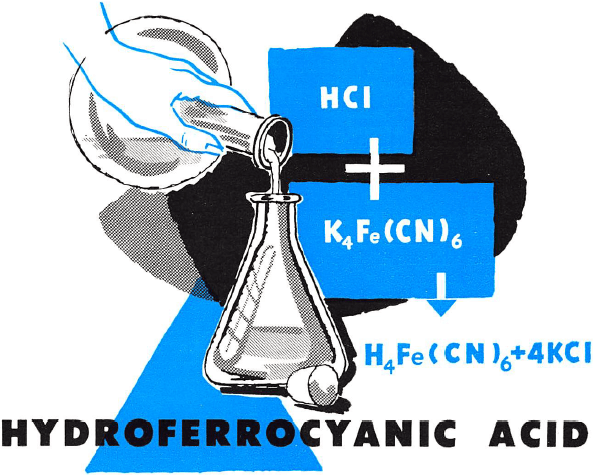Table of Contents

PHYSICAL PROPERTIES of Hydroferrocyanic Acid

Hydroferrocyanic acid is most conveniently prepared by the treatment of an alkali metal ferrocyanide with a strong mineral acid. A typical preparation would involve the treatment of a saturated aqueous solution of potassium ferrocyanide with concentrated hydrochloric acid. The acid separates as a crystalline solid that may be purified further by solution in ethanol and reprecipitation by the addition of ether.
Hydroferrocyanic Acid CHEMICAL PROPERTIES
Outside of neutralization and esterification, the chemical reactions of hydroferrocyanic acid are limited chiefly to the formation of addition compounds. These are formed with sulfuric acid, alcohols, ethers, aldehydes, ketones, and certain hydrocarbons. A brief description of the formation of these adducts and other reactions involving essentially nonionized hydroferrocyanic acid is given in the following paragraphs. Reactions of the acid in aqueous solution are included in the chapter dealing with the chemical properties of the ferrocyanide ion.
Reaction with Sulfuric Acid
The addition of small amounts of water to a saturated solution of hydroferrocyanic acid in concentrated sulfuric acid leads to the formation of a series of addition products that are said to have the following composition:
H4Fe(CN)6 x H2SO4 where x = 5, 6, or 7
All of these products decompose upon exposure to damp air. If hydroferrocyanic acid is dissolved in warm sulfuric acid, the solution heated to 100- 110°C. and then cooled, a compound having the composition 2H3Fe(CN)6·SO3H·7H2SO4, is formed. With fuming sulfuric acid the primary product is thought to be 2H2Fe(CN)6SO2·3H2S2O7. Similar reactions occur between sulfuric acid and anhydrous potassium ferrocyanide (p. 30).
Compounds of hydroferrocyanic acid with sulfuric acid are said to decompose upon heating with the generation of carbon monoxide, carbon dioxide, and nitrogen.
Esterification
If hydrogen chloride is passed into a solution of hydroferrocyanic acid in methyl, ethyl, propyl, n-amyl, tert-amyl, or tert-butyl alcohol, esterification occurs, which may be postulated as follows:
H4Fe(CN)6 + 6 ROH + 2 HCl → R6Fe(CN)6Cl2 + 6 H2O
Considerable evidence has been presented for the existence of an isocyanide structure in these complexes:
Fe(RNC)6Cl2 or R2Fe(RNC)4(CN)2Cl2
The products are decomposed by exposure to the atmosphere, forming hydrogen chloride, alcohol, and hydroferrocyanic acid.
Esters of hydroferrocyanic acid may be prepared by dissolving the above complexes in a small amount of water and reprecipitating them by the addition of ether. This change also has been effected by heating the complexes to 140°C.
![]()
The esters also may be prepared by the alkylation of silver or potassium ferrocyanide by alkyl iodides, or by the action of diazomethane on hydroferrocyanic acid etherate. The esters generally are soluble in alcohol, chloroform, and water and give a strong isocyanide odor when heated with base. The composition of the esters is believed to be as shown above.
It is interesting to note that x-ray data indicate that the esters exist in two geometrically isomeric forms, cis and trans. The cis form reacts with methyl iodide, whereas the trans does not. The two forms also differ in solubility. Monoalkyl esters of hydroferricyanic acid have been prepared, H2RFe(CN)6.
Complex products similar in composition to those obtained from alcohols have resulted from treatment of potassium ferrocyanide with dimethyl sulfate and from the reaction of alkyl ferrocyanides with alkyl halides. With dimethyl sulfate a variety of products may be obtained by altering the reaction conditions.
K4Fe(CN)6 + 4 (CH3)2SO4 → Fe(CH3NC)6(CH3SO4)2 + 2 K2SO4
K4Fe(CN)6 + 3 (CH3)2SO4 → Fe(CH3NC)6SO4 + 2 K2SO4
K4Fe(CN)6 + 4 (CH3)2SO4 + 2 H2O → Fe(CH3NC)6(HSO4)2 + 2 K(CH3)SO4 + 2 KOH
Complex Formation
With Alcohols. In the absence of strong acids, alcohols form with hydroferrocyanic acid addition compounds that apparently hold the alcohol as a solvate molecule. Products of the type H4Fe(CN)6xROH have been reported for methyl, ethyl, and allyl alcohols. Treatment of a methanol solution of hydroferrocyanic acid with ether is said to yield the unstable product, H4Fe(CN)6CH3OH·(C2H5)2O.
With Ethers. If aqueous solutions of hydroferrocyanic acid are covered with a layer of diethyl ether, an addition compound containing both the ether and the acid is formed at the interface. This product is formed also by the treatment of the crystalline acid with anhydrous ether, although it is believed that water accelerates the reaction. Wet ether reacts with a considerable evolution of heat and swelling of the product, whereas anhydrous ether produces a less vigorous reaction. The amount of ether which is involved in the addition varies with temperature. Thus at 0°C. the product contains 2.7 moles of ether, and at 22°C. it contains 2.35 moles of ether.
A product with 2 moles of ether has been reported. The complex may be formed also by exposure of hydroferrocyanic acid to ether vapor or by the addition of ether to a concentrated alcoholic solution of the acid. The ether is said to be removed completely if the product is heated to 40-50°C. in vacuum or in a dry hydrogen stream at 50 °C. and at 80-110 °C. Storage over sulfuric acid, or standing for some time in air also results in decomposition.
Diisoamyl ether and aromatic ethers have been reported not to react with hydroferrocyanic acid.
With Aldehydes and Ketones. Crystalline addition products are formed between hydroferrocyanic or hydroferricyanic acid and practically all unhindered aldehydes and ketones. The reaction may be conducted in water. Furfural and acetone may be cited as particular reactants. The products are very high- melting and essentially insoluble in the common solvents.
With Unsaturated Hydrocarbons. Insoluble, crystalline addition products of hydroferrocyanic acid with camphene and with azulene have been reported. In the former case the product is believed to be (C10H18)2· H2Fe(CN)6. The azulene adduct has the composition C15H18.H4Fe(CN)6.
